Organizational Behavior: Impact of Motivation Techniques Report
VerifiedAdded on 2020/03/16
|6
|1708
|498
Report
AI Summary
This report delves into the field of organizational behavior, specifically examining the impact of motivation techniques employed by managers to enhance employee performance and productivity. The study emphasizes the significance of motivation in fostering a positive work environment and its influence on individual and organizational success. It explores both intrinsic and extrinsic motivation, providing examples of how managers can implement various strategies, such as offering incentives, recognition, and opportunities for growth, to boost employee engagement and job satisfaction. The report highlights the importance of understanding employee needs and tailoring motivational approaches accordingly. It also discusses the role of training, skill development, and the overall organizational structure in shaping employee efficiency. The findings underscore the critical link between effective motivation and the achievement of organizational goals, emphasizing the need for managers to continuously evaluate and refine their motivational practices to optimize employee performance and drive overall business success. The report also touches on the impact of motivation on aspects like employee turnover and absenteeism, reinforcing the need for a holistic approach to employee well-being and productivity.
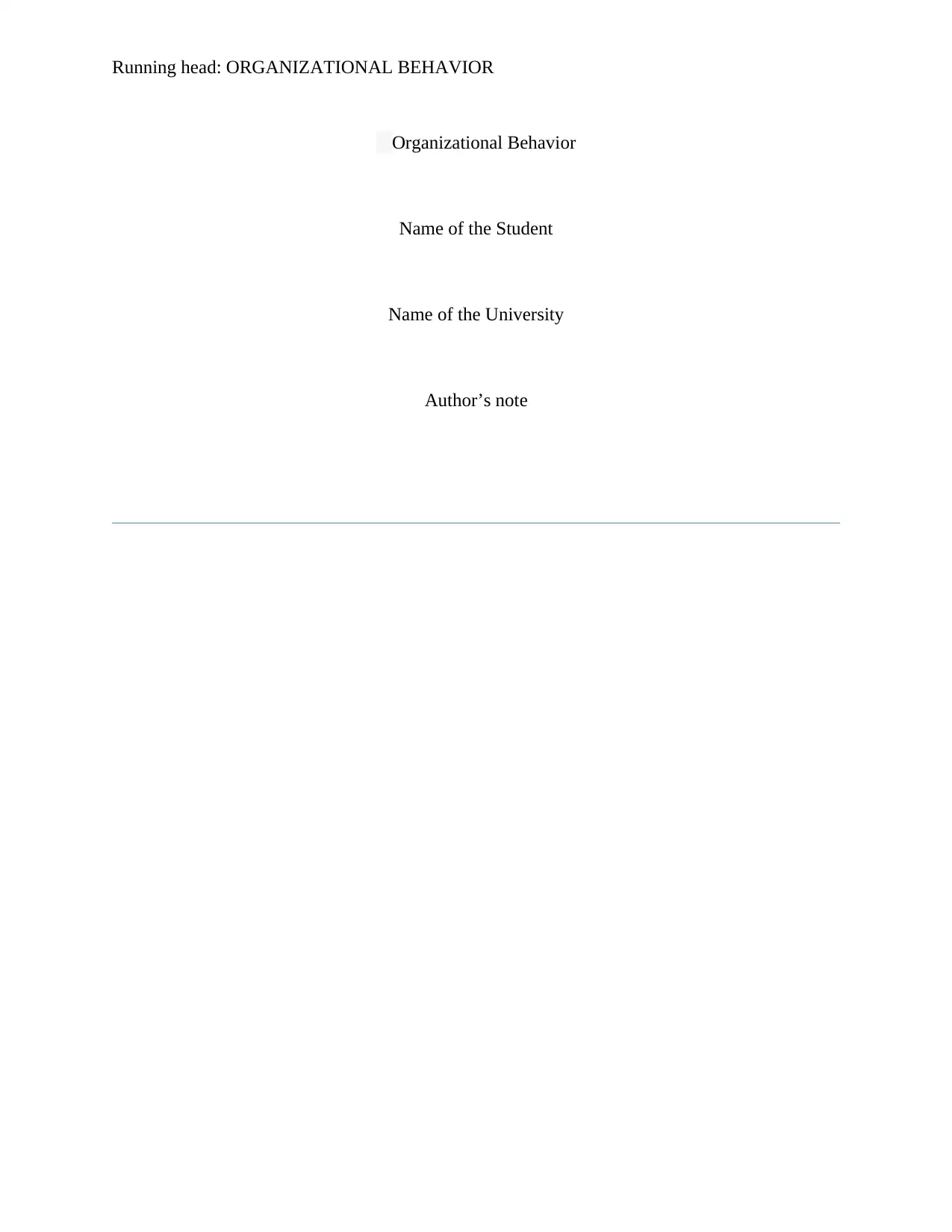
Running head: ORGANIZATIONAL BEHAVIOR
Organizational Behavior
Name of the Student
Name of the University
Author’s note
Organizational Behavior
Name of the Student
Name of the University
Author’s note
Paraphrase This Document
Need a fresh take? Get an instant paraphrase of this document with our AI Paraphraser
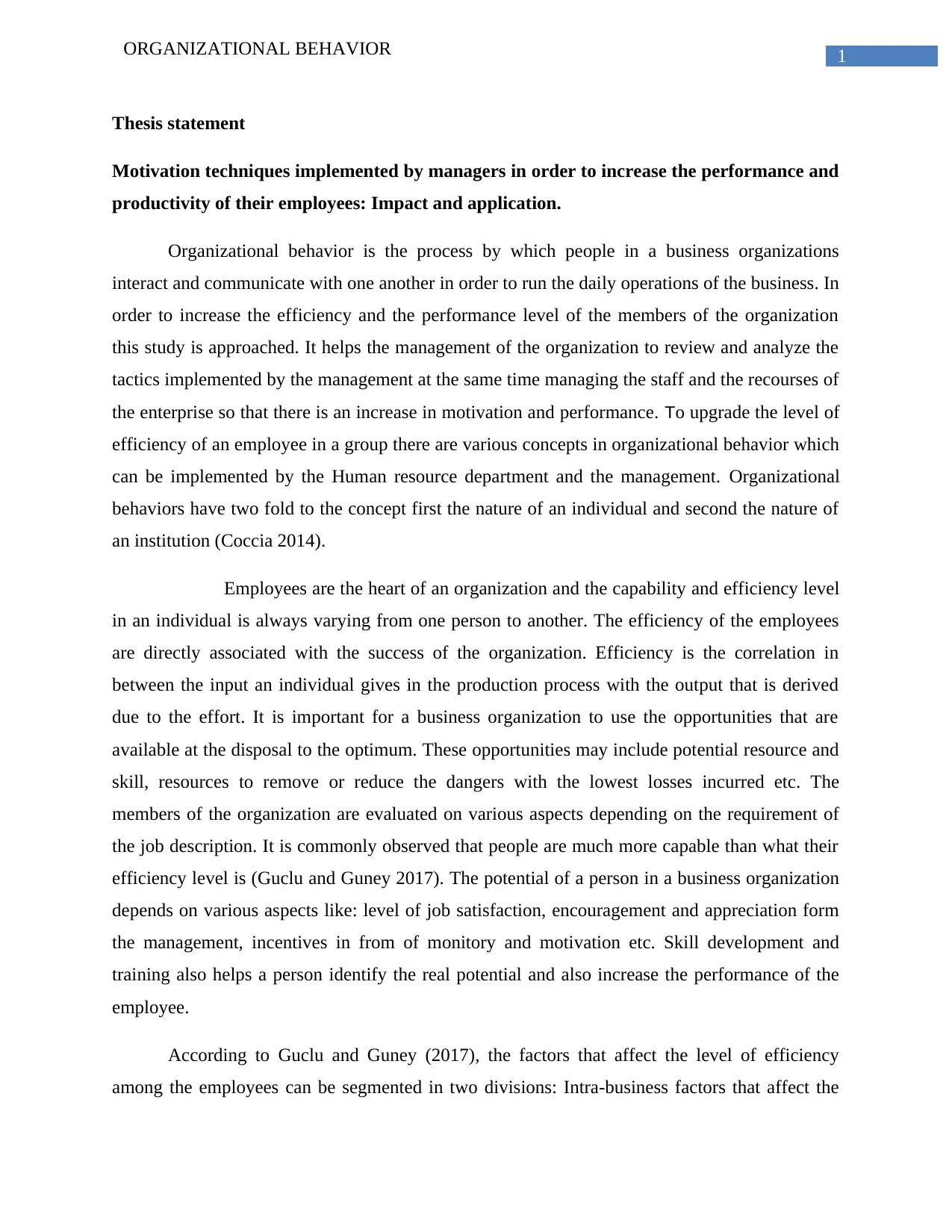
1ORGANIZATIONAL BEHAVIOR
Thesis statement
Motivation techniques implemented by managers in order to increase the performance and
productivity of their employees: Impact and application.
Organizational behavior is the process by which people in a business organizations
interact and communicate with one another in order to run the daily operations of the business. In
order to increase the efficiency and the performance level of the members of the organization
this study is approached. It helps the management of the organization to review and analyze the
tactics implemented by the management at the same time managing the staff and the recourses of
the enterprise so that there is an increase in motivation and performance. To upgrade the level of
efficiency of an employee in a group there are various concepts in organizational behavior which
can be implemented by the Human resource department and the management. Organizational
behaviors have two fold to the concept first the nature of an individual and second the nature of
an institution (Coccia 2014).
Employees are the heart of an organization and the capability and efficiency level
in an individual is always varying from one person to another. The efficiency of the employees
are directly associated with the success of the organization. Efficiency is the correlation in
between the input an individual gives in the production process with the output that is derived
due to the effort. It is important for a business organization to use the opportunities that are
available at the disposal to the optimum. These opportunities may include potential resource and
skill, resources to remove or reduce the dangers with the lowest losses incurred etc. The
members of the organization are evaluated on various aspects depending on the requirement of
the job description. It is commonly observed that people are much more capable than what their
efficiency level is (Guclu and Guney 2017). The potential of a person in a business organization
depends on various aspects like: level of job satisfaction, encouragement and appreciation form
the management, incentives in from of monitory and motivation etc. Skill development and
training also helps a person identify the real potential and also increase the performance of the
employee.
According to Guclu and Guney (2017), the factors that affect the level of efficiency
among the employees can be segmented in two divisions: Intra-business factors that affect the
Thesis statement
Motivation techniques implemented by managers in order to increase the performance and
productivity of their employees: Impact and application.
Organizational behavior is the process by which people in a business organizations
interact and communicate with one another in order to run the daily operations of the business. In
order to increase the efficiency and the performance level of the members of the organization
this study is approached. It helps the management of the organization to review and analyze the
tactics implemented by the management at the same time managing the staff and the recourses of
the enterprise so that there is an increase in motivation and performance. To upgrade the level of
efficiency of an employee in a group there are various concepts in organizational behavior which
can be implemented by the Human resource department and the management. Organizational
behaviors have two fold to the concept first the nature of an individual and second the nature of
an institution (Coccia 2014).
Employees are the heart of an organization and the capability and efficiency level
in an individual is always varying from one person to another. The efficiency of the employees
are directly associated with the success of the organization. Efficiency is the correlation in
between the input an individual gives in the production process with the output that is derived
due to the effort. It is important for a business organization to use the opportunities that are
available at the disposal to the optimum. These opportunities may include potential resource and
skill, resources to remove or reduce the dangers with the lowest losses incurred etc. The
members of the organization are evaluated on various aspects depending on the requirement of
the job description. It is commonly observed that people are much more capable than what their
efficiency level is (Guclu and Guney 2017). The potential of a person in a business organization
depends on various aspects like: level of job satisfaction, encouragement and appreciation form
the management, incentives in from of monitory and motivation etc. Skill development and
training also helps a person identify the real potential and also increase the performance of the
employee.
According to Guclu and Guney (2017), the factors that affect the level of efficiency
among the employees can be segmented in two divisions: Intra-business factors that affect the
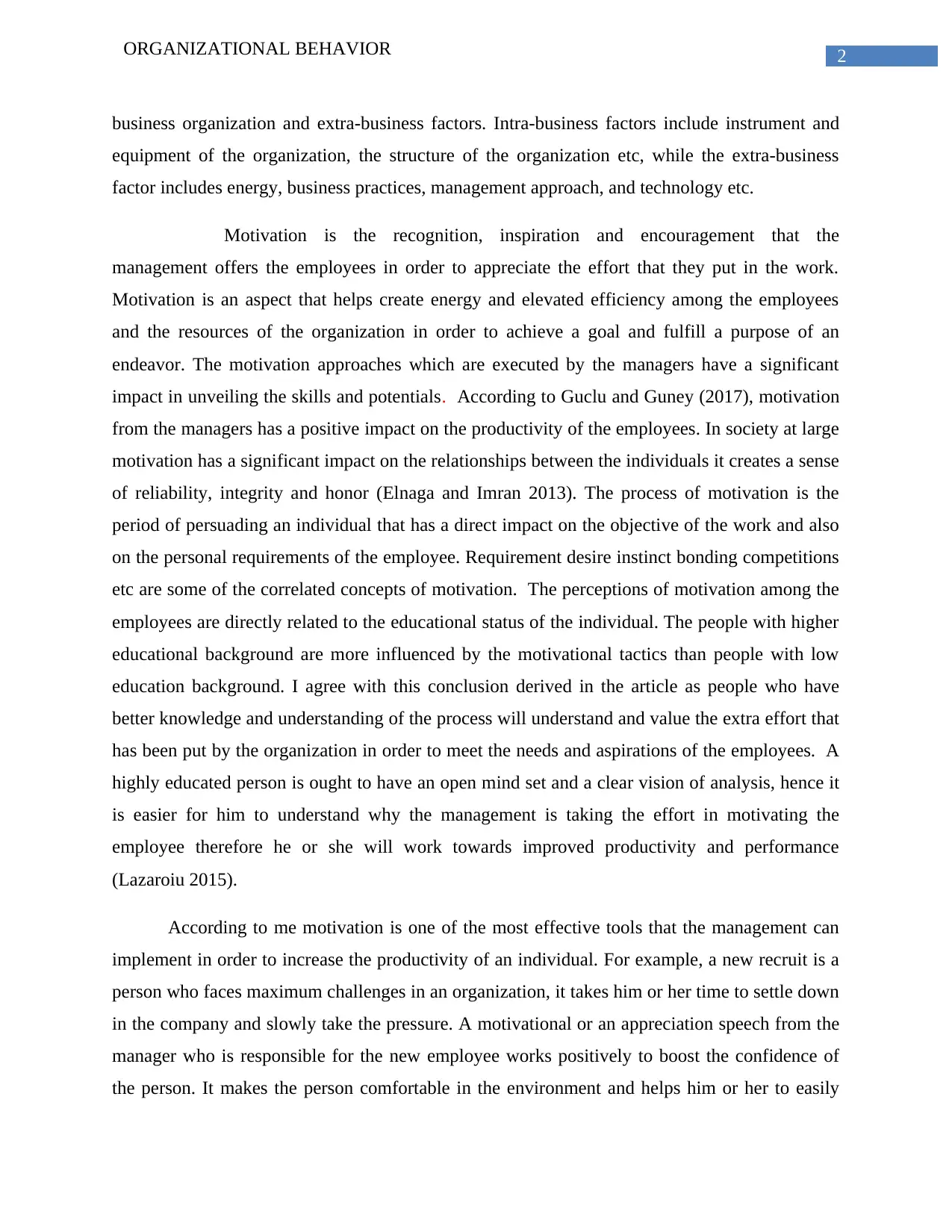
2ORGANIZATIONAL BEHAVIOR
business organization and extra-business factors. Intra-business factors include instrument and
equipment of the organization, the structure of the organization etc, while the extra-business
factor includes energy, business practices, management approach, and technology etc.
Motivation is the recognition, inspiration and encouragement that the
management offers the employees in order to appreciate the effort that they put in the work.
Motivation is an aspect that helps create energy and elevated efficiency among the employees
and the resources of the organization in order to achieve a goal and fulfill a purpose of an
endeavor. The motivation approaches which are executed by the managers have a significant
impact in unveiling the skills and potentials. According to Guclu and Guney (2017), motivation
from the managers has a positive impact on the productivity of the employees. In society at large
motivation has a significant impact on the relationships between the individuals it creates a sense
of reliability, integrity and honor (Elnaga and Imran 2013). The process of motivation is the
period of persuading an individual that has a direct impact on the objective of the work and also
on the personal requirements of the employee. Requirement desire instinct bonding competitions
etc are some of the correlated concepts of motivation. The perceptions of motivation among the
employees are directly related to the educational status of the individual. The people with higher
educational background are more influenced by the motivational tactics than people with low
education background. I agree with this conclusion derived in the article as people who have
better knowledge and understanding of the process will understand and value the extra effort that
has been put by the organization in order to meet the needs and aspirations of the employees. A
highly educated person is ought to have an open mind set and a clear vision of analysis, hence it
is easier for him to understand why the management is taking the effort in motivating the
employee therefore he or she will work towards improved productivity and performance
(Lazaroiu 2015).
According to me motivation is one of the most effective tools that the management can
implement in order to increase the productivity of an individual. For example, a new recruit is a
person who faces maximum challenges in an organization, it takes him or her time to settle down
in the company and slowly take the pressure. A motivational or an appreciation speech from the
manager who is responsible for the new employee works positively to boost the confidence of
the person. It makes the person comfortable in the environment and helps him or her to easily
business organization and extra-business factors. Intra-business factors include instrument and
equipment of the organization, the structure of the organization etc, while the extra-business
factor includes energy, business practices, management approach, and technology etc.
Motivation is the recognition, inspiration and encouragement that the
management offers the employees in order to appreciate the effort that they put in the work.
Motivation is an aspect that helps create energy and elevated efficiency among the employees
and the resources of the organization in order to achieve a goal and fulfill a purpose of an
endeavor. The motivation approaches which are executed by the managers have a significant
impact in unveiling the skills and potentials. According to Guclu and Guney (2017), motivation
from the managers has a positive impact on the productivity of the employees. In society at large
motivation has a significant impact on the relationships between the individuals it creates a sense
of reliability, integrity and honor (Elnaga and Imran 2013). The process of motivation is the
period of persuading an individual that has a direct impact on the objective of the work and also
on the personal requirements of the employee. Requirement desire instinct bonding competitions
etc are some of the correlated concepts of motivation. The perceptions of motivation among the
employees are directly related to the educational status of the individual. The people with higher
educational background are more influenced by the motivational tactics than people with low
education background. I agree with this conclusion derived in the article as people who have
better knowledge and understanding of the process will understand and value the extra effort that
has been put by the organization in order to meet the needs and aspirations of the employees. A
highly educated person is ought to have an open mind set and a clear vision of analysis, hence it
is easier for him to understand why the management is taking the effort in motivating the
employee therefore he or she will work towards improved productivity and performance
(Lazaroiu 2015).
According to me motivation is one of the most effective tools that the management can
implement in order to increase the productivity of an individual. For example, a new recruit is a
person who faces maximum challenges in an organization, it takes him or her time to settle down
in the company and slowly take the pressure. A motivational or an appreciation speech from the
manager who is responsible for the new employee works positively to boost the confidence of
the person. It makes the person comfortable in the environment and helps him or her to easily
⊘ This is a preview!⊘
Do you want full access?
Subscribe today to unlock all pages.

Trusted by 1+ million students worldwide
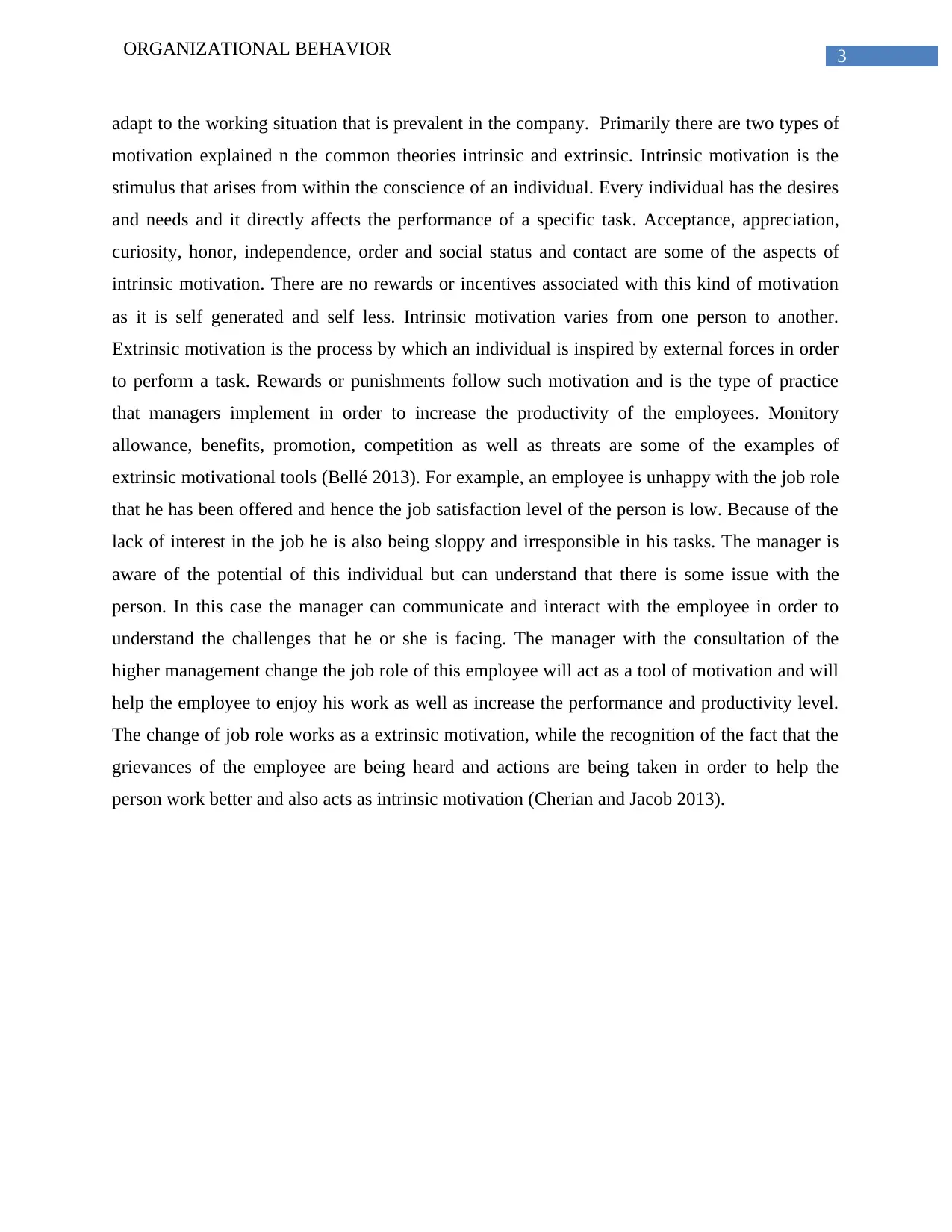
3ORGANIZATIONAL BEHAVIOR
adapt to the working situation that is prevalent in the company. Primarily there are two types of
motivation explained n the common theories intrinsic and extrinsic. Intrinsic motivation is the
stimulus that arises from within the conscience of an individual. Every individual has the desires
and needs and it directly affects the performance of a specific task. Acceptance, appreciation,
curiosity, honor, independence, order and social status and contact are some of the aspects of
intrinsic motivation. There are no rewards or incentives associated with this kind of motivation
as it is self generated and self less. Intrinsic motivation varies from one person to another.
Extrinsic motivation is the process by which an individual is inspired by external forces in order
to perform a task. Rewards or punishments follow such motivation and is the type of practice
that managers implement in order to increase the productivity of the employees. Monitory
allowance, benefits, promotion, competition as well as threats are some of the examples of
extrinsic motivational tools (Bellé 2013). For example, an employee is unhappy with the job role
that he has been offered and hence the job satisfaction level of the person is low. Because of the
lack of interest in the job he is also being sloppy and irresponsible in his tasks. The manager is
aware of the potential of this individual but can understand that there is some issue with the
person. In this case the manager can communicate and interact with the employee in order to
understand the challenges that he or she is facing. The manager with the consultation of the
higher management change the job role of this employee will act as a tool of motivation and will
help the employee to enjoy his work as well as increase the performance and productivity level.
The change of job role works as a extrinsic motivation, while the recognition of the fact that the
grievances of the employee are being heard and actions are being taken in order to help the
person work better and also acts as intrinsic motivation (Cherian and Jacob 2013).
adapt to the working situation that is prevalent in the company. Primarily there are two types of
motivation explained n the common theories intrinsic and extrinsic. Intrinsic motivation is the
stimulus that arises from within the conscience of an individual. Every individual has the desires
and needs and it directly affects the performance of a specific task. Acceptance, appreciation,
curiosity, honor, independence, order and social status and contact are some of the aspects of
intrinsic motivation. There are no rewards or incentives associated with this kind of motivation
as it is self generated and self less. Intrinsic motivation varies from one person to another.
Extrinsic motivation is the process by which an individual is inspired by external forces in order
to perform a task. Rewards or punishments follow such motivation and is the type of practice
that managers implement in order to increase the productivity of the employees. Monitory
allowance, benefits, promotion, competition as well as threats are some of the examples of
extrinsic motivational tools (Bellé 2013). For example, an employee is unhappy with the job role
that he has been offered and hence the job satisfaction level of the person is low. Because of the
lack of interest in the job he is also being sloppy and irresponsible in his tasks. The manager is
aware of the potential of this individual but can understand that there is some issue with the
person. In this case the manager can communicate and interact with the employee in order to
understand the challenges that he or she is facing. The manager with the consultation of the
higher management change the job role of this employee will act as a tool of motivation and will
help the employee to enjoy his work as well as increase the performance and productivity level.
The change of job role works as a extrinsic motivation, while the recognition of the fact that the
grievances of the employee are being heard and actions are being taken in order to help the
person work better and also acts as intrinsic motivation (Cherian and Jacob 2013).
Paraphrase This Document
Need a fresh take? Get an instant paraphrase of this document with our AI Paraphraser
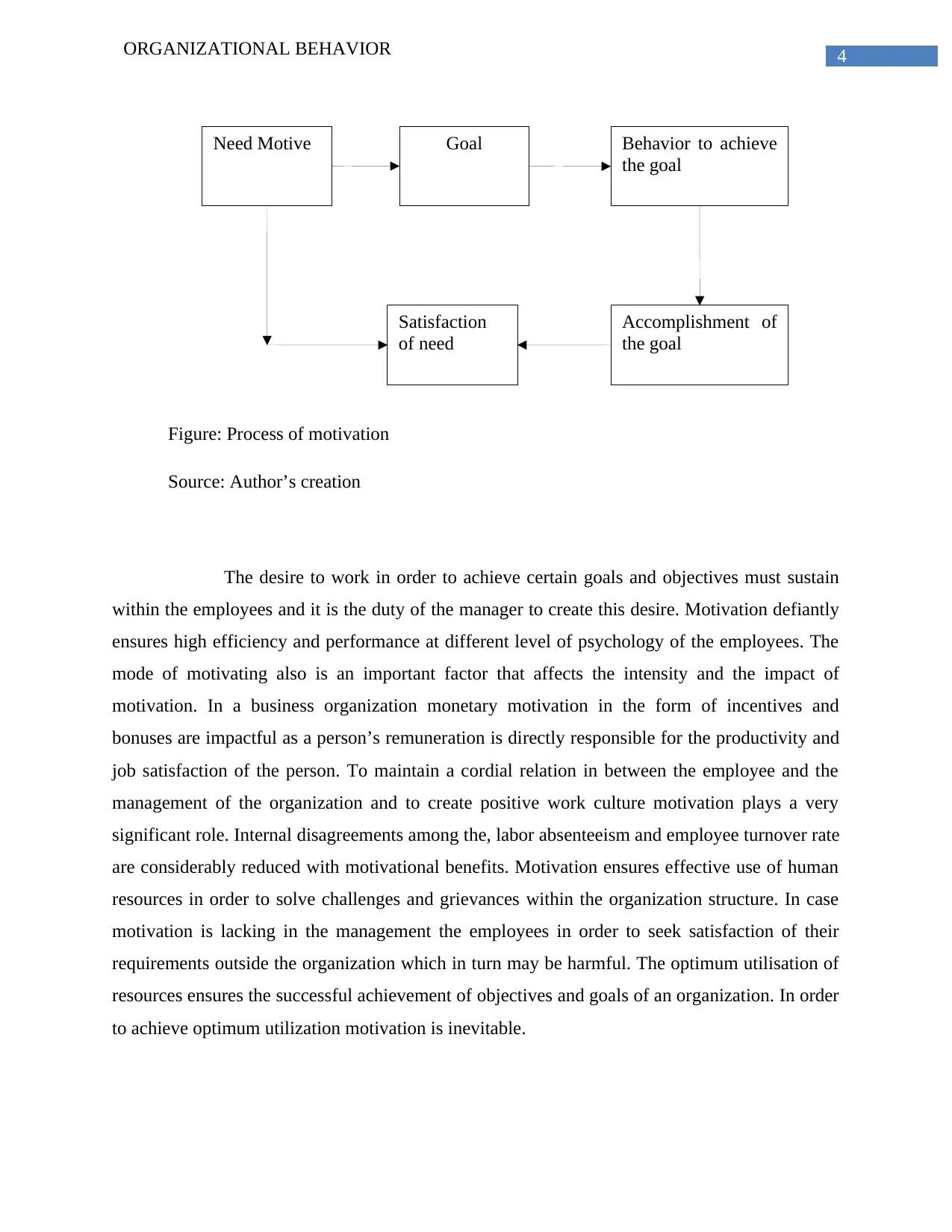
4ORGANIZATIONAL BEHAVIOR
Need Motive Goal Behavior to achieve
the goal
Accomplishment of
the goal
Satisfaction
of need
Figure: Process of motivation
Source: Author’s creation
The desire to work in order to achieve certain goals and objectives must sustain
within the employees and it is the duty of the manager to create this desire. Motivation defiantly
ensures high efficiency and performance at different level of psychology of the employees. The
mode of motivating also is an important factor that affects the intensity and the impact of
motivation. In a business organization monetary motivation in the form of incentives and
bonuses are impactful as a person’s remuneration is directly responsible for the productivity and
job satisfaction of the person. To maintain a cordial relation in between the employee and the
management of the organization and to create positive work culture motivation plays a very
significant role. Internal disagreements among the, labor absenteeism and employee turnover rate
are considerably reduced with motivational benefits. Motivation ensures effective use of human
resources in order to solve challenges and grievances within the organization structure. In case
motivation is lacking in the management the employees in order to seek satisfaction of their
requirements outside the organization which in turn may be harmful. The optimum utilisation of
resources ensures the successful achievement of objectives and goals of an organization. In order
to achieve optimum utilization motivation is inevitable.
Need Motive Goal Behavior to achieve
the goal
Accomplishment of
the goal
Satisfaction
of need
Figure: Process of motivation
Source: Author’s creation
The desire to work in order to achieve certain goals and objectives must sustain
within the employees and it is the duty of the manager to create this desire. Motivation defiantly
ensures high efficiency and performance at different level of psychology of the employees. The
mode of motivating also is an important factor that affects the intensity and the impact of
motivation. In a business organization monetary motivation in the form of incentives and
bonuses are impactful as a person’s remuneration is directly responsible for the productivity and
job satisfaction of the person. To maintain a cordial relation in between the employee and the
management of the organization and to create positive work culture motivation plays a very
significant role. Internal disagreements among the, labor absenteeism and employee turnover rate
are considerably reduced with motivational benefits. Motivation ensures effective use of human
resources in order to solve challenges and grievances within the organization structure. In case
motivation is lacking in the management the employees in order to seek satisfaction of their
requirements outside the organization which in turn may be harmful. The optimum utilisation of
resources ensures the successful achievement of objectives and goals of an organization. In order
to achieve optimum utilization motivation is inevitable.
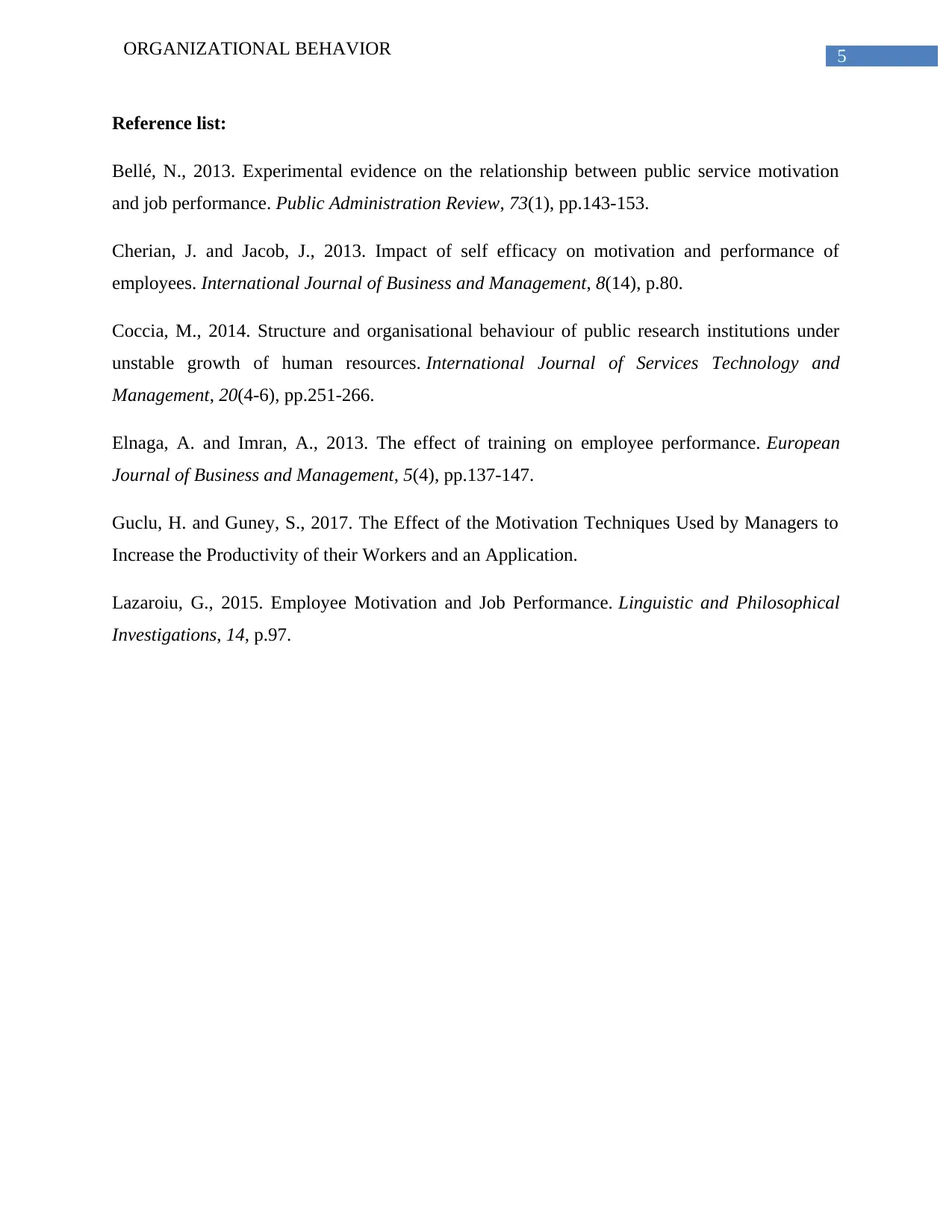
5ORGANIZATIONAL BEHAVIOR
Reference list:
Bellé, N., 2013. Experimental evidence on the relationship between public service motivation
and job performance. Public Administration Review, 73(1), pp.143-153.
Cherian, J. and Jacob, J., 2013. Impact of self efficacy on motivation and performance of
employees. International Journal of Business and Management, 8(14), p.80.
Coccia, M., 2014. Structure and organisational behaviour of public research institutions under
unstable growth of human resources. International Journal of Services Technology and
Management, 20(4-6), pp.251-266.
Elnaga, A. and Imran, A., 2013. The effect of training on employee performance. European
Journal of Business and Management, 5(4), pp.137-147.
Guclu, H. and Guney, S., 2017. The Effect of the Motivation Techniques Used by Managers to
Increase the Productivity of their Workers and an Application.
Lazaroiu, G., 2015. Employee Motivation and Job Performance. Linguistic and Philosophical
Investigations, 14, p.97.
Reference list:
Bellé, N., 2013. Experimental evidence on the relationship between public service motivation
and job performance. Public Administration Review, 73(1), pp.143-153.
Cherian, J. and Jacob, J., 2013. Impact of self efficacy on motivation and performance of
employees. International Journal of Business and Management, 8(14), p.80.
Coccia, M., 2014. Structure and organisational behaviour of public research institutions under
unstable growth of human resources. International Journal of Services Technology and
Management, 20(4-6), pp.251-266.
Elnaga, A. and Imran, A., 2013. The effect of training on employee performance. European
Journal of Business and Management, 5(4), pp.137-147.
Guclu, H. and Guney, S., 2017. The Effect of the Motivation Techniques Used by Managers to
Increase the Productivity of their Workers and an Application.
Lazaroiu, G., 2015. Employee Motivation and Job Performance. Linguistic and Philosophical
Investigations, 14, p.97.
⊘ This is a preview!⊘
Do you want full access?
Subscribe today to unlock all pages.

Trusted by 1+ million students worldwide
1 out of 6
Related Documents
Your All-in-One AI-Powered Toolkit for Academic Success.
+13062052269
info@desklib.com
Available 24*7 on WhatsApp / Email
![[object Object]](/_next/static/media/star-bottom.7253800d.svg)
Unlock your academic potential
Copyright © 2020–2025 A2Z Services. All Rights Reserved. Developed and managed by ZUCOL.





